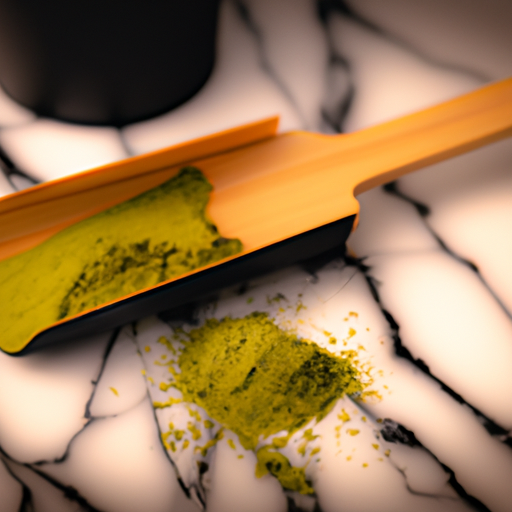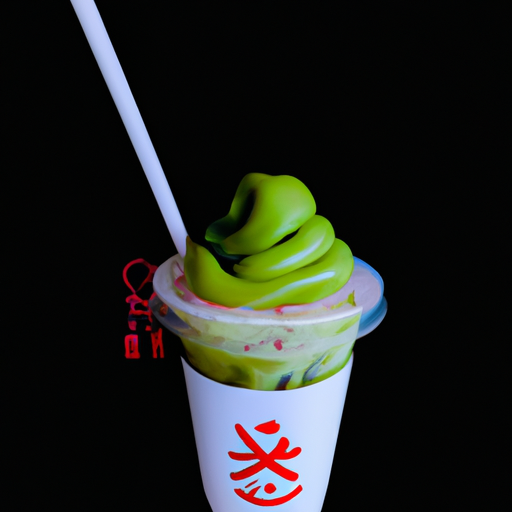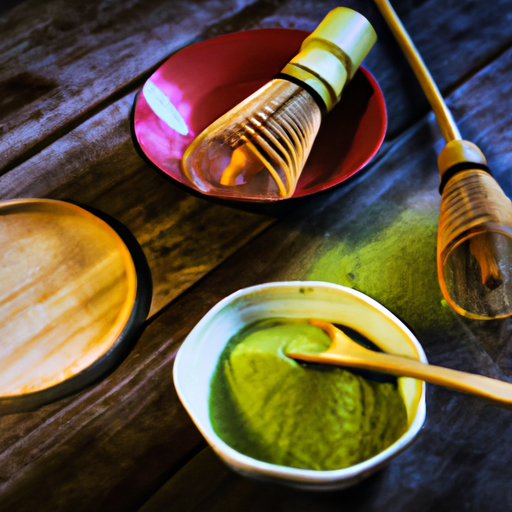Hello, fellow enthusiasts of tea! I’m thrilled to present to you my preferred method for crafting a delightful Green Tea Matcha Latte. This beverage, with its creamy frothiness, is not just flavorful but also brimming with health advantages, making it an ideal choice for kicking off your day or as a refreshing boost in the afternoon.
To get started, you’ll need a few simple ingredients: matcha powder, milk (regular or plant-based), sweetener of choice (optional), and a whisk. Once you have everything gathered together, we can begin the process of creating this delicious drink.
So let’s dive in!
Key Takeaways
- Making a green tea matcha latte requires matcha powder, milk, and sweetener, with the option to customize with different flavors and milk types.
- Proper preparation involves sifting the matcha powder, heating the milk without boiling, and whisking the matcha powder to create a frothy texture.
- Green tea matcha latte has numerous health benefits, including high levels of antioxidants and nutrients, aiding in weight loss, and improving brain function.
- Tips for making a perfect green tea matcha latte include using high-quality matcha powder, avoiding overheating the milk, and experimenting with different sweeteners and milk types to find the perfect combination.
Gather Your Ingredients
Grab all the necessary ingredients for your delicious green tea matcha latte, including sweet honey, creamy milk, and vibrant matcha powder. When choosing the right matcha powder, go for high-quality brands that are bright green in color and finely ground. Avoid powders with a yellowish tint or clumpy texture as they may produce a bitter taste.
Preparing your matcha powder for optimal taste is crucial to achieving a smooth and delicious latte. Start by sifting 1-2 teaspoons of matcha powder into a small bowl to remove any lumps. Then, add 1-2 tablespoons of hot water and whisk briskly until the mixture becomes frothy and lump-free. This process will help release the full flavor of the tea leaves while preventing any gritty residue from settling at the bottom of your cup.
Now that you have prepared your matcha powder, it’s time to heat your milk. Simply pour 8 ounces of milk into a small saucepan over medium heat and warm until steaming but not boiling. Be sure to use whole milk or plant-based alternatives such as almond or coconut milk for a creamier texture.
Once heated, pour the milk into your favorite mug and get ready to mix in your freshly prepared matcha mixture for an indulgent treat!
Heat Your Milk
So, now that I’ve got all my ingredients ready, it’s time to heat up some milk for my green tea matcha latte.
First things first, I need to choose the right milk – preferably one with a higher fat content like whole or 2% milk.
Once I’ve got my milk of choice, it’s important to heat it properly without scorching or boiling it. This will ensure a smooth and creamy texture for my latte.
Choose the Right Milk
For a creamy and indulgent green tea matcha latte, you’ll want to use a milk that complements the earthy flavor of matcha. When it comes to choosing the right milk for your latte, there are plenty of options available.
If you’re lactose intolerant or vegan, you can opt for plant-based alternatives such as soy milk, almond milk or oat milk. These types of milk alternatives not only offer a unique taste but also have different levels of sweetness and creaminess. However, keep in mind that the choice of milk is crucial in achieving that perfect matcha latte.
The type and temperature of your chosen milk will affect not just its taste but also its texture when frothed up for latte art. So, make sure to choose wisely and experiment with different varieties until you find one that suits your taste buds perfectly.
With the right kind of milk, heating it properly is key to making an amazing matcha latte – which we’ll discuss in detail in the next section!
Heat the Milk Properly
To achieve a velvety texture in your matcha latte, it’s crucial to heat the milk properly, like treating a delicate flower with gentle care. Proper milk heating can make or break your matcha latte experience. The key is to avoid boiling the milk and scorching its natural sweetness.
There are various milk frothing techniques you can use to heat the milk for your matcha latte. You can either use a handheld frother or an electric one, both of which can create foam and add volume to your drink. However, if you don’t have any frothers at home, you can simply heat the milk on low heat and whisk it gently until it reaches your desired temperature.
Remember that overheating may ruin the taste of your matcha latte so always keep an eye on the temperature gauge. Once done, you’re now ready to sift your matcha powder!
Sift Your Matcha Powder
When making a matcha latte, it’s important not to overlook the step of sifting your matcha powder. Sifting helps break up any clumps and ensures a smooth, consistent texture in your drink.
To sift matcha powder, simply use a fine mesh strainer or sifter. Gently tap it over a bowl to remove any lumps before adding it to your milk mixture.
Why Sifting is Important
First, you’ll want to grab a fine mesh strainer to sift your matcha powder before making your latte. This step is crucial for ensuring a smooth and clump-free consistency in your drink. Sifting ensures that any lumps or impurities are removed from the powder, resulting in a finer texture that dissolves easily in liquid.
Additionally, sifting aerates the matcha powder which can enhance its flavor profile and create a frothy texture when mixed with milk.
Apart from improving the texture and taste of your matcha latte, sifting also has numerous benefits for consuming matcha powder itself. Matcha is high in antioxidants and nutrients such as chlorophyll, amino acids, vitamins A and C, potassium, and calcium.
By sifting it before use, you remove any clumps or debris that may affect these nutrients’ absorption into the body. With these benefits in mind, let’s move on to learn how to sift matcha powder properly so we can make our perfect cup of green tea matcha latte!
How to Sift Matcha Powder
Don’t forget, sifting your matcha powder is crucial for achieving a smooth and lump-free consistency that enhances both the texture and flavor of your final product.
To sift matcha powder, you will need a fine mesh strainer or a tea filter. Place the strainer over a small bowl and add the desired amount of matcha powder on top. Gently tap or shake the strainer to sift the powder through. This process removes any lumps or clumps that may form during storage or transportation.
Alternative sifting methods include using a traditional Japanese tea strainer called a furui or using an electric flour sifter for larger batches.
It’s important to note that using high quality matcha powder also plays a significant role in achieving optimal taste and texture. Look for bright green color, fine particles, and sweet aroma when selecting matcha powder for your latte recipe.
After sifting, whisk the matcha powder in hot water until frothy before adding milk and sweetener according to personal preference.
Whisk the Matcha Powder
Now that my matcha powder is sifted, it’s time to whisk it properly. I prefer using a bamboo whisk for this step as it helps to create a frothy and smooth texture.
To start, I scoop about two teaspoons of matcha powder into my bowl and pour in hot water (about 70°C or 160°F). Then, using quick back-and-forth motions with the bamboo whisk, I blend the mixture until it becomes frothy.
Use a Bamboo Whisk
To achieve a smooth and frothy texture, you’ll want to use a bamboo whisk when preparing your green tea matcha latte. While there are alternatives such as electric whisks or metal whisks, using a bamboo whisk has its benefits.
The delicate and flexible tines of the bamboo whisk allow for air to be incorporated into the mixture more easily, resulting in a lighter and creamier consistency. Moreover, using a bamboo whisk can enhance the flavor of your green tea matcha latte.
Unlike metal or plastic utensils that can add unwanted metallic or plastic tastes, bamboo is neutral in taste and won’t affect the flavor profile of your drink. With all these advantages in mind, it’s clear that choosing to use a bamboo whisk is the best way to go when making your green tea matcha latte.
Now let’s move on to how to properly whisk with one!
How to Whisk Properly
Whisking your frothy beverage with a bamboo whisk is like performing a graceful dance that’s sure to impress even the most stoic of coffee snobs. To achieve the perfect matcha latte, it’s important to master proper whisking techniques. Here are some tips to ensure you get it right:
-
Use a zigzag motion: Moving your wrist back and forth in quick, zigzag motions will create tiny air bubbles that give your latte its signature frothiness.
-
Don’t overdo it: While you want to create plenty of foam, be careful not to overwhisk your matcha as this can cause it to become clumpy or bitter.
-
Keep the water temperature in mind: Matcha powder dissolves best in hot but not boiling water (around 175°F), so make sure you’re using water that’s just below boiling point.
-
Be patient: Properly whisking your matcha latte can take a few minutes, so don’t rush the process.
However, even with these tips, there are some common mistakes while whisking that may still occur. For example, adding too much water at once can cause lumps and prevent the matcha from dissolving properly. Or if you’re using an electric frother instead of a bamboo whisk, be careful not to overdo it as this can also lead to bitterness.
With practice and patience, though, you’ll soon be able to whip up perfectly creamy and delicious matcha lattes every time.
To add sweetener to taste, simply stir in your preferred amount of honey or sugar after you’ve finished whisking your latte mixture until everything is dissolved.
Add Sweetener to Taste
If you’re looking for a little sweetness in your matcha latte, go ahead and add your favorite sweetener until it’s just right! Experiment with different sweeteners to find the perfect one that complements the earthy taste of matcha. Whether you prefer honey, agave, or stevia, adding a touch of sweetness can elevate your matcha latte experience.
Customize your matcha latte sweetness according to your preferences. If you want a stronger flavor, add more sweetener. If you prefer a milder taste, use less. Keep in mind that too much sugar can overpower the subtle flavors of matcha and make it too sweet. So always start with small amounts and adjust accordingly.
Now that you’ve added the desired amount of sweetener to your matcha powder mixture, it’s time to pour the milk into the matcha. This process will blend all the ingredients together and create a frothy texture on top.
Pour the Milk into the Matcha
Once you’ve got your sweetener just right, it’s time to pour in the creamy milk and watch as the magic happens! The type of milk you choose will affect both the flavor and texture of your matcha latte. Traditional cow’s milk is a popular option, but alternative milks like almond, soy, or oat can add a unique twist.
When pouring the milk into the matcha, make sure to do so slowly and steadily while whisking or stirring constantly. This will help create a smooth and frothy texture that is characteristic of lattes. If using cow’s milk or an alternative that has been heated on the stove or in a steamer, be careful not to scorch it or let it boil over.
Flavor combinations are endless when it comes to matcha lattes. For example, adding vanilla extract or cinnamon can give your drink a warm and cozy feel. Alternatively, mixing in honey or agave nectar can provide sweetness without overwhelming the natural bitterness of matcha tea.
Once you’ve poured in your chosen milk and stirred in any additional flavors, it’s time to move onto the final step: use latte art techniques to create an eye-catching design on top of your green tea matcha latte!
Use Latte Art Techniques
I love adding a personal touch to my green tea matcha latte by using latte art techniques. It’s amazing how a simple design can make the drink look more appealing and even elevate its taste!
In this subtopic, I’ll discuss some basic latte art designs and share tips on how to create them.
Basic Latte Art Designs
To achieve a touch of elegance in your green tea matcha latte, consider mastering basic latte art designs such as hearts, rosettas, and tulips. These designs may seem simple at first glance but require practice to perfect.
Here are some tips to help you get started:
- Begin by pouring the milk slowly into the center of the cup.
- Once the cup is half full, start moving the pitcher back and forth in a zigzag motion while continuing to pour.
- For a heart design, gently move the pitcher towards one side of the cup and then pull it through to create a point at the bottom.
- For a rosetta design, use a combination of circular motions with quick flicks of your wrist to create leaves around a central circle.
Mastering basic latte art designs can be challenging but is an essential skill for any barista or home brewer looking to impress their guests.
In the next section, we’ll dive deeper into how to create latte art with advanced techniques that’ll take your skills to the next level.
How to Create Latte Art
If you want to elevate your latte game and impress your guests, mastering the art of creating intricate designs in your milk foam is a crucial skill that requires practice and patience.
Latte art trends are constantly evolving, with new techniques and designs emerging regularly. From simple hearts and rosettas to more complex designs like swans and dragons, there are endless possibilities when it comes to creating latte art.
To create latte art, there are different types of techniques that you can use. The most common ones include free pouring, etching, and stenciling.
Free pouring involves simply pouring milk into espresso while moving the pitcher back and forth to create patterns on the surface of the drink. Etching involves using a tool like a toothpick or skewer to draw designs on top of the milk foam after it has been poured. Stenciling involves placing a stencil on top of the milk foam before dusting cocoa powder or cinnamon over it to create an image.
With practice, anyone can learn these techniques and start creating beautiful latte art designs for their drinks. Now that you’ve learned how to create different types of latte art techniques, it’s time to serve and enjoy your masterpiece!
Serve and Enjoy
When it comes to serving matcha lattes, I like mine hot and frothy. The recommended serving temperature is around 160-175°F (70-80°C), which allows for the full flavor of the matcha to come through.
I find that the best time to enjoy a matcha latte is in the morning or afternoon as a pick-me-up, but it can also be a great way to wind down at night with a decaf version.
Recommended Serving Temperature
For the perfect creamy and comforting matcha latte experience, aim for a serving temperature that’s just hot enough to soothe your soul without scalding your taste buds.
Different types of milk can affect the temperature at which you should serve your matcha latte. For example, if using almond milk, it’s best to heat it up until it’s warm but not boiling since almond milk tends to curdle when heated too much. On the other hand, if you’re using cow’s milk or oat milk, heating it up until steaming hot is ideal.
While many enjoy their matcha latte hot, there are also benefits to drinking it cold. Cold matcha lattes are perfect for those who prefer a refreshing and energizing drink during hotter months. Additionally, cold lattes tend to have a more pronounced tea flavor than their hot counterparts.
So whether you prefer your matcha latte hot or cold, make sure to find the perfect temperature that suits your taste buds! And now onto the next section: when’s the best time to enjoy a delicious matcha latte?
Best Time to Enjoy a Matcha Latte
Indulging in a perfectly brewed matcha latte at the right time of day can give you a much-needed boost of energy and calmness. So, what’s the best time to enjoy a matcha latte? Here are some suggestions:
-
In the morning: Starting your day with a cup of matcha latte can help you feel energized and focused. The caffeine in green tea provides a gentle lift without the jitters that coffee may cause.
-
Afternoon slump: Feeling tired or unfocused in the afternoon? A matcha latte can provide an invigorating pick-me-up without disrupting your sleep later on.
-
Evening relaxation: Matcha contains L-theanine, an amino acid that promotes relaxation and reduces stress. Sipping on a warm matcha latte before bedtime can help you unwind and prepare for restful sleep.
Drinking a matcha latte at any time during the day has its benefits. However, drinking it during these suggested times will maximize its effects for relaxation and rejuvenation.
Now let’s explore some variations on the classic recipe.
Variations on the Classic Recipe
You simply can’t go wrong with adding a splash of vanilla extract to your green tea matcha latte—it’s like taking a trip to flavor heaven.
But that’s not the only way you can switch up the classic recipe. Have you ever tried making your matcha latte with almond or coconut milk? These different types of non-dairy milk add a creamy texture and unique taste that pairs perfectly with the earthy flavor of matcha.
Another variation on the classic recipe is to add some honey or agave syrup for sweetness. Not only does this enhance the taste, but it also adds some health benefits.
Matcha lattes are already known for being packed with antioxidants and providing an energy boost without the crash associated with coffee, but adding these natural sweeteners further boosts their nutritional value.
Speaking of health benefits, did you know that matcha lattes are loaded with them? From boosting metabolism and aiding in weight loss to improving brain function and reducing stress levels, there’s no denying that this vibrant green drink packs quite a punch.
So, why not experiment with different variations on the classic recipe and enjoy all these amazing health benefits at once?
Health Benefits of Matcha Lattes
Now that we’ve explored some delicious variations on the classic matcha latte recipe, let’s talk about the health benefits of this tasty drink.
As someone who’s always looking for ways to improve my overall well-being, I was delighted to discover that matcha lattes offer a whole host of advantages.
Firstly, let’s compare matcha with coffee. While both drinks contain caffeine, matcha also contains an amino acid called L-theanine which promotes relaxation and reduces stress levels. This means you won’t experience the jitters or caffeine crash that often comes with consuming coffee. Additionally, matcha provides a more sustained energy boost without affecting blood pressure or heart rate like coffee can.
Another great benefit of drinking matcha lattes is their potential for promoting weight loss. Matcha contains powerful antioxidants called catechins which have been shown to increase metabolism and aid in fat burning. When combined with exercise and a healthy diet, incorporating matcha lattes into your routine could help you reach your fitness goals faster and more efficiently than relying on coffee alone.
So not only do they taste amazing, but they’re also incredibly good for you!
Frequently Asked Questions
What is the difference between regular green tea and matcha tea?
When it comes to green tea, there are many variations available. However, matcha tea is unique in its cultivation and benefits.
Matcha tea is made by grinding specifically grown green tea leaves into a fine powder that dissolves in water. This means that when you drink matcha, you’re consuming the entire leaf and all of its nutrients. This makes matcha higher in antioxidants than regular green tea, which can help fight against disease and improve overall health.
Additionally, the cultivation of matcha involves shading the plants for several weeks before harvest to increase chlorophyll production and give the leaves a vibrant green color. These two aspects – the whole-leaf consumption and shading process – make matcha stand out from other types of green tea.
Can I use any type of milk for making a matcha latte?
I’ve been experimenting with different types of milk when making matcha lattes, and I can confidently say that there are plenty of alternative milks that work just as well as regular dairy milk.
Almond milk, soy milk, coconut milk, oat milk – they all have unique flavors that can add an interesting twist to your latte. For example, using almond milk will give your latte a nuttier flavor while coconut milk will make it creamier and slightly tropical.
It’s really up to personal preference but don’t be afraid to try something new!
What is the best type of sweetener to use for a matcha latte?
When it comes to sweetening a matcha latte, there are a variety of options available. However, if you want to keep things natural and healthy, your best bet is to choose a natural sweetener like monk fruit or honey.
Both of these options add a touch of sweetness without adding any artificial flavors or chemicals. While some people may prefer the taste of artificial sweeteners, they often come with negative health effects that can outweigh their benefits.
Ultimately, when it comes down to choosing between natural vs artificial sweeteners for your matcha latte, it’s important to consider both taste and health benefits before making your decision.
How can I store my matcha powder to keep it fresh?
To keep my matcha powder fresh, I follow a few simple tips. First, I make sure to store it in an airtight container away from light and moisture. This helps preserve its quality and extend its shelf life.
Additionally, I try to use it within three months of opening the package to ensure optimal freshness. When it comes to packaging options, I prefer resealable bags or jars with tight-fitting lids for easy access and convenience.
While I primarily use matcha for making lattes, there are plenty of other creative ways to incorporate it into recipes such as smoothies, baked goods, and even savory dishes like stir-fries or soups. Not only does matcha offer unique flavor pairings and health benefits such as antioxidants and energy-boosting properties, but it also adds beautiful color and depth to any dish.
Overall, proper storage techniques coupled with experimenting with different matcha recipes can lead to endless possibilities for enjoying this versatile ingredient.
What are some common mistakes to avoid when making a matcha latte?
Avoiding mistakes is crucial when making a matcha latte. As someone who’s made countless lattes, I can confidently say that it’s easy to mess up this delicious drink.
One of the biggest mistakes people make is not properly whisking the matcha powder with hot water before adding milk. This results in clumps of matcha powder at the bottom of your cup and an uneven flavor throughout your drink.
Another mistake to avoid is using too much milk or not enough sweetener. A good rule of thumb is to use a 1:3 ratio of matcha powder to milk and add sweetener according to personal taste preferences.
Lastly, be sure to use high-quality ingredients and equipment for optimal taste and presentation. By following these tips and tricks, you’ll be able to make a perfect matcha latte every time!
Conclusion
In conclusion, making a green tea matcha latte isn’t as complicated as it may seem. With just a few simple steps and some patience, you can enjoy this delicious and healthy drink in the comfort of your own home.
However, some people may argue that matcha lattes are too expensive to make at home or take too much time. While it’s true that high-quality matcha powder can be pricey, investing in a good brand will ensure that you get the full flavor and health benefits of this superfood.
Additionally, taking the time to make yourself a warm and comforting beverage can be a form of self-care and mindfulness in our busy lives.
So why not try making a green tea matcha latte today? Not only will it satisfy your taste buds, but it also offers numerous health benefits such as boosting metabolism and providing antioxidants.
Treat yourself to something special without breaking the bank or sacrificing your precious time.










